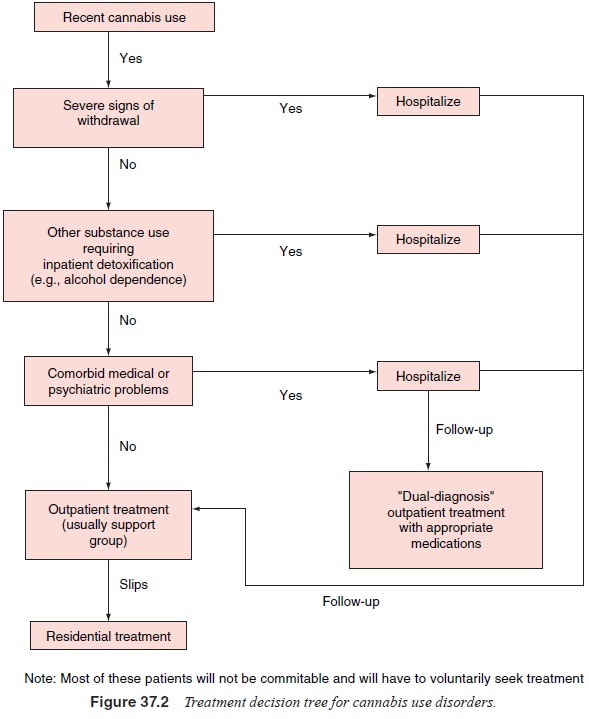Chapter: Essentials of Psychiatry: Substance Abuse: Cannabis-related Disorders
Special Features Influencing Treatment - Cannabis-related Disorders
Special Features Influencing
Treatment
Several approaches that are more important to the
treatment of cannabis dependence should be employed in addition to the basic,
general substance abuse program. Recent studies examining rea-sons for cannabis
use have provided information to guide treat-ment strategies. For example, both
adolescent and adult cannabis users frequently report that they use cannabis to
relax, or as a stress reduction or coping mechanism. This observation suggests
that treatment programs should teach healthier and more effec-tive coping
mechanisms and cognitive–behavioral strategies for relaxation and stress
reduction (Botvin, 2000; Hendin and Haas, 1985; Weiner et al., 1999).
The most salient feature of cannabis abuse or
dependence is that it is often comorbid with other Axis I disorders as
discussed earlier. Toxicology screening for other drugs of abuse is impera-tive
because the most common comorbid Axis I disorders are other types of substance
abuse. Even in the absence of an obvious Axis I diagnosis, psychological
reasons for cannabis use should be investigated. For example, use of cannabis
for relaxation or improving mood may be indicative of efforts to
“self-medicate” underlying anxiety or mood disorders (Chen and Kandel, 1998;
Latimer et al., 2000). Thus,
treatment programs for cannabis de-pendence should include a dual-diagnosis
component. Because of the high frequency of comorbidity among
cannabis-dependent individuals, diagnosing and treating the underlying disorder
or symptomatology may be a necessary condition for the individual to stop using
marijuana (Brady et al., 1991;
Cantwell et al., 1999;
Crits-Christoph and Siqueland, 1996; Johns, 2001; Menezes et al., 1996; Regier et al.,
1990; Rounds-Bryant et al., 1999;
Simpson, 1981; Simpson et al., 1997;
Troisi et al., 1998).
Another treatment situation frequently encountered is that of an individual with a known Axis I disorder that is being exacerbated by cannabis use. Some studies, performed in populations of patients with schizophrenia, have found that cannabis use worsens the course of the illness, whereas others have found that it does not affect the course (Negrete et al., 1986; Treffert, 1978; Cuffel et al., 1993; Linszen et al., 1994). It is a reasonable assumption that at least some patients with Axis I disorders are adversely affected by cannabis use even if they use the drug only occasionally. In such cases, the role of cannabis as an exacerbat-ing factor must be assessed and discussed with the patient. These patients may or may not be suitable for support groups directed primarily at substance abuse because cannabis may represent a relatively minor portion of the patient’s overall clinical picture.
Refractory Patients and Nonresponse to Initial Treatment
Like alcohol, the most common problem in managing
cannabis use disorders is the high rate of relapse due to the wide availability
of the drug and the large number of people who are users. Users are therefore
tempted to resume use soon after a period of treat-ment when they find
themselves in situations where they are sur-rounded by people using the
substance. It is often useful for fami-lies and other people important in the
patient’s life to get involved in treatment to understand the role that they
play in the patient’s substance abuse. Some treaters advocate periodic random
urine testing, which is an inexpensive and reliable method of monitor-ing
abstinence, because THC remains present for such a long time and can be
detected with infrequent testing (Miller et
al., 1989).
A difficult treatment situation arises when it is
hypothe-sized that the patient is using cannabis to self-medicate a primary
Axis I disorder such as depression or an anxiety disorder. In these
individuals, abstinence is difficult to achieve because the patient believes
that cannabis will alleviate his or her symptoms. Relapse may occur repeatedly
until the underlying Axis I disorder is ef-fectively treated (Peralta and
Cuesta, 1992; Dixon et al., 1991;
Estroff and Gold, 1986; Warner et al.,
1994).
Cannabis-induced Disorders
Uncomplicated cannabis intoxication rarely comes to
clinical at-tention and, if it does, it does not require treatment other than
re-assurance, as it is a self-limiting condition. Similarly, as suggested in
the previous sections, symptoms of delirium, psychosis, or anx-iety associated
with cannabis use typically resolve promptly af-ter the period of acute
intoxication is past. Again, no treatment is necessary other than keeping the
patient safe and providing reas-surance that symptoms caused by the drug will stop,
as these are also self-limiting conditions. If the symptoms continue after more
than 24 to 48 hours of abstinence from the drug, the possibility of another
Axis I diagnosis must be considered. In such cases, treat-ment should then be
directed at the primary Axis I disorder.
In the given treatment decision tree a diagnosis of
canna-bis use disorders is presented Figure 37.2.

Related Topics